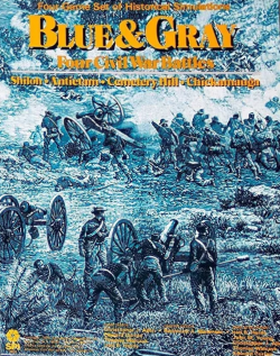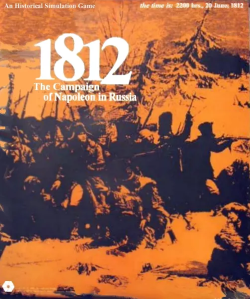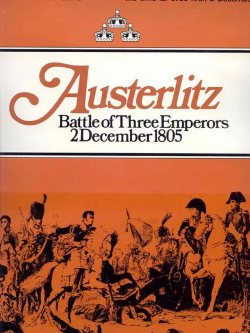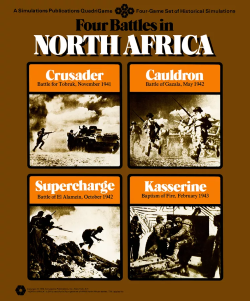
The Battle of Borodino: Napoleon in Russia 1812 is a board wargame published by Simulations Publications Inc. (SPI) in 1972 that is a simulation of the Battle of Borodino during the French invasion of Russia in 1812.

The Battle of Borodino: Napoleon in Russia 1812 is a board wargame published by Simulations Publications Inc. (SPI) in 1972 that is a simulation of the Battle of Borodino during the French invasion of Russia in 1812.
In June 1812, Napoleon invaded Russia and forced Russian forces to retreat. By September, French forces had advanced to the outskirts of Moscow, where the Russians made a stand, setting up a strong defensive position near the small village of Borodino. After a fierce battle with heavy losses on both sides, the Russians made an orderly retreat, opening the road to Moscow and providing Napoleon with a Pyrrhic victory. Although the French briefly occupied Moscow, the oncoming winter and lack of supplies forced the French to immediately withdraw from Russia, with the loss of a significant portion of the French army to disease, cold and starvation. [1]
The Battle of Borodino is a 2-player wargame that uses the same rules system as SPI's popular Napoleon at Waterloo game published the year before. Turns are "I go, You Go", where one player moves their pieces and engages in combat, and then the other player gets the same opportunity. [2]
The game includes:
Each unit can move up to the limit of its movement rate. Units cannot enter a forest except via roads, and cannot cross rivers except via a bridge or specified ford. (Using a ford costs two extra points of movement.) Units can cross a stream at the cost of one extra point of movement. French units cannot enter the front of a Russian redoubt or fleche. [3]
Units adjacent to enemy units must attack, unless separated by a river. Artillery can fire upon non-adjacent units that are one hex away. To simulate the strong defensive works thrown up by the Russians, Russian unit strength is doubled when a French attack is directed through the front of a redoubt or fleche. Likewise, a unit's defensive strength is doubled when in a town or a forest. Attacks cannot be made across a river except at bridges and fords, where the attacker's strength is halved. [3]
The game comes with four different scenarios: September 5, September 6, September 7, and Grand Battle, which is a combination of the first three scenarios. [3]
In 1971, SPI offered the small and simple wargame Napoleon at Waterloo as a free bonus that came with a subscription to their house magazine Strategy & Tactics . The following year, John Young designed a Napoleonic game based on the rules used in Napoleon at Waterloo. [4] The result was The Battle of Borodino, published as a pull-out game in Strategy & Tactics No. 32 (May 1972) with graphic design by Redmond A. Simonsen. SPI subsequently released it as a boxed set, first in a plain white box with a red title ribbon, and then in a "flat pack" box. [2]
It proved to be a popular game; in a 1976 poll conducted by SPI to determine the most popular board wargames in North America, Borodino placed 23rd out of 202 games, despite being four years old. [4]
Writing in Moves only a few months after Borodino was published, Martin Campion noted, "So far the two sides seem well-balanced, but the French have to be very careful on the first day as they come on the board in driblets that can be overwhelmed in detail if they don't treat the Russians with respect." [5] Writing in The Guide to Simulations/Games for Education and Training almost a decade later, Campion called this "a simple game but it can be a lengthy one." He concluded, "The mechanics are not very reliable but the game looks very authentic and the problems of the game are analogous to the problems of the actual battle." [6]
In his 1977 book The Comprehensive Guide to Board Wargaming , Nicholas Palmer called this a "Very simple and fast-moving game, based on the introductory Napoleon at Waterloo , yet durably popular with the hard-core." [4]
Although Roy Gibson called Borodino "One of my favorite SPI games, played more frequently than any other single game", he did note several problems, and in the first two issues of Phoenix , wrote extensive outlines of how the game could be improved:
In the 1980 book The Complete Book of Wargames , game designer Jon Freeman called this "a very simple game based on a very complex battle." He found the first-day scenario favored the French, while the other scenarios favored the Russians. Noting that the game was 8 years old at the time of his writing, Freeman concluded, "Although the game is a far cry from the current state of the art, its challenges and the simple system used make it an entertaining and fast-moving game for novice and veteran gamers alike." [9]

Armageddon: Tactical Combat, 3000-500 BC is a board wargame first published by Simulations Publications Inc. (SPI) in 1972 in Strategy & Tactics, then released as a stand-alone game, then reimplemented as Chariot: Tactical Warfare in the "Biblical" Age, 3000-500 BC.

Napoleon's Last Battles is a board wargame published by Simulations Publications in 1976 that simulates the last four battles fought by Napoleon. It was one of SPI's most popular games, and also received many positive reviews.
La Bataille de la Moscowa is a board wargame published originally by Martial Enterprises in 1975, later republished by Game Designers Workshop in 1977, and by Clash of Arms in 2011.

Blue & Gray: Four American Civil War Battles is a board wargame originally published by Simulations Publications, Inc. (SPI) in 1975 that simulates four battles from the American Civil War.

1812: The Campaign of Napoleon in Russia is a collection of two board wargames published by Simulations Publications Inc. (SPI) in 1972 that both simulate Napoleon's disastrous invasion of Russia. One game uses a traditional hex grid map, and the other uses a map of areas and regions.

La Grande Armée, subtitled "The Campaigns of Napoleon in Central Europe", is a board wargame published by Simulations Publications Inc. (SPI) in 1972 that simulates three campaigns of Napoleon.

Kursk: Operation Zitadelle is a board wargame published by Simulations Publications Inc. (SPI) in 1971. It was the first wargame to simulate the Battle of Kursk, the large tank battle during World War II.

Marengo: Napoleon in Italy, 14 June 1800 is a board wargame published by Simulations Publications Inc. (SPI) in 1975 as one of four games packaged together in the Napoleon at War "quadrigame". Marengo was also released as a separate game the same year. The game simulates the Battle of Marengo between Austrian and French forces.

Napoleon at War, subtitled "Four Battles", is a collection of four board wargames published by Simulations Publications Inc. (SPI) in 1975 that simulates various battles fought by Napoleon.

Napoleon at Waterloo is a board wargame published by Simulations Publications Inc. (SPI) in 1971 that simulates the Battle of Waterloo. The game, which features simple rules, was designed as an introduction to board wargaming, and was given as a free gift with each subscription to SPI's Strategy & Tactics magazine.

Rocroi, subtitled "19 May 1643 – The End of Spanish Ascendancy", is a board wargame published by Simulations Publications Inc. (SPI) in 1976 that simulates the 1643 Battle of Rocroi during the Thirty Years' War. Rocroi was originally sold as one of four separate games packaged together in Thirty Years War, a "quadrigame", but it was also published as an individual game. It received mixed reviews from critics, some of whom called it a "bland tactical problem", while others declared it was the best game of the four in the Thirty Years War box.

Freiburg, subtitled "3–9 August 1644 – Conquest of the Rhine Valley", is a board wargame published by Simulations Publications Inc. (SPI) in 1976 that simulates the 1644 Battle of Freiburg during the Thirty Years' War. Freiburg was originally sold as one of four separate games packaged together in Thirty Years War, a "quadrigame", but it was also published as an individual game. It received poor reviews from critics, who called it the weakest of the four games in the Thirty Years War box, "a series of slogging matches", "not much fun", and "relatively boring."

Austerlitz, subtitled "The Battle of Three Emperors, 2 December 1805", is a board wargame published by Simulations Publications Inc. (SPI) in 1972 that simulates the Battle of Austerlitz between Napoleon's French forces, and the Austrian-Russian forces of the Third Coalition.
Tsushima is a board wargame published by Game Designers' Workshop (GDW) in 1975 that simulates naval battles during the Russo-Japanese War of 1904-1905. Tsushima was part of a two-game collection titled The Russo-Japanese War. The second game in the box was Port Arthur, which covered the land combat during the war. The two games could either be played separately, or combined into one master game.

Four Battles in North Africa is a collection of four board wargames published in 1976 by Simulations Publications, Inc. (SPI) that simulate various battles during the North African Campaign of World War II.

The Battle of Nations, subtitled "The Encirclement at Leipzig, 16–19 October 1813", is a board wargame published by Simulations Publications Inc. (SPI) in 1975 that simulates the Battle of Leipzig in 1813. It was one of four games that were published as part of the "quadrigame" titled Napoleon at War, but was also released as a "folio game", packaged in a shrinkwrapped cardboard folio. It was popular in a 1976 poll of favorite wargames, and critics also gave it favorable reviews.

Jena-Auerstadt: The Battle for Prussia is a board wargame published by Simulations Publications Inc. (SPI) in 1975 that simulates the twin battles of Jena and Auerstadt in October 1806. It was one of four games that were part of the "quadrigame" titled Napoleon at War, but it was also released as an individual "folio game" packaged in a shrinkwrapped cardstock folio. Jena-Auerstadt was rated highly in a 1976 poll of favorite wargames, but critics questioned whether its simplicity was capable of simulating a complicated two-part battle.

Grenadier, subtitled "Tactical Warfare 1680–1850", is a board wargame published by Simulations Publications Inc. (SPI) in 1972 that simulates combat during an age when musket and cannon predominated.

Strike Force One, subtitled "The Cold War Heats Up — 1975", is a board wargame published by Simulations Publications Inc. (SPI) during the Cold War in 1975 that simulates a hypothetical clash in West Germany between Soviet Union invaders, and American defenders. The short and simple game was designed as an introduction to the hobby of wargaming, and was given away as a free promotional item.

Waterloo is a Napoleonic board wargame published by Avalon Hill in 1963 that simulates the Battle of Waterloo. It was one of the first board wargames produced and despite its lack of historicity and complexity, it still received positive comments more than twenty years later as a fun and playable game, and remained in Avalon Hill's catalogue until 1990.